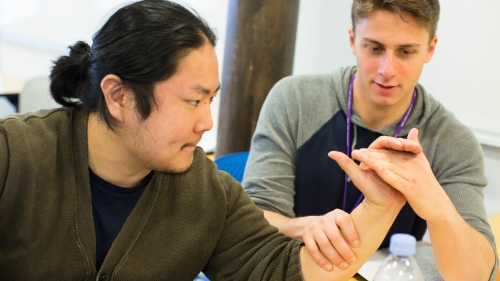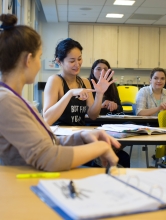Occupational therapy (OT) is a highly flexible and adaptive career path that lets you use your knowledge of human functioning to help clients successfully tackle the life activities that are most important to them.
OTs are trained to look at clients' environments and make recommendations to increase functional activity, from families of children seeking to make their classroom more accessible for their needs to adults who are learning to bathe and dress again after a stroke or other traumatic injury.
Using Your Creativity to Improve Lives

Becoming an OT is an excellent way to help patients in a holistic way that goes beyond just the physical symptoms of an injury or disorder.
“OT training includes a strong background in psycho-social work, such as courses related to behavioral problems and mental health,” says Patricia A. Gentile, clinical assistant professor of occupational therapy and program director of NYU Steinhardt’s Entry-Level Doctorate in Occupational Therapy (EL-OTD).
“Having a lifelong or catastrophic illness can affect a person’s self-image and how they interact with the world, so as their OT you need to look at each person in totality,” says Gentile. “It’s about asking them ‘What do you need and want to do during a typical day?’ and then you work together to come up with modifications to help them work and live better. There’s a lot of skill involved with matching patients’ ability to their individual life demands.”

Flexibility to Pursue Personal Passions
OTs can use their expertise helping people of all ages and abilities, in school systems, care facilities, hospitals, homeless shelters, immigrant communities, corporations, and more.
“The biggest perk for people considering a career in OT is that you can work in so many different settings – you can find your niche anywhere,” says Courtney Jacoby (MS OT ’21), related service coordinator and practicing OT at Hawthorne Country Day School, a private, not-for-profit school in New York for children with serious disabilities. “There are so many options for specialization, such as working with assistive technology or doing consulting, so you can find your own strength. Plus, the risk of burnout can be high in healthcare, and as an OT you can switch your focus easily while maintaining your forward momentum.”
A Solid Career Choice
OTs are in high demand – according to the U.S. Bureau of Labor Statistics, employment of occupational therapists is projected to grow 11 percent from 2023 to 2033, much faster than the average for all occupations. Plus, the median annual wage for occupational therapists is around $98,000.
Is the EL-OTD Program Right for You?

With a supportive community and a strong curriculum taught by leading educators and clinicians, NYU Steinhardt’s EL-ODT program will prepare you to become a licensed OT with additional knowledge and skills in leadership, scholarship, advocacy, and advanced clinical competence.
If you are looking for a diverse range of fieldwork and research opportunities strengthened by a dynamic New York City location, then NYU Steinhardt could be the place for you.
